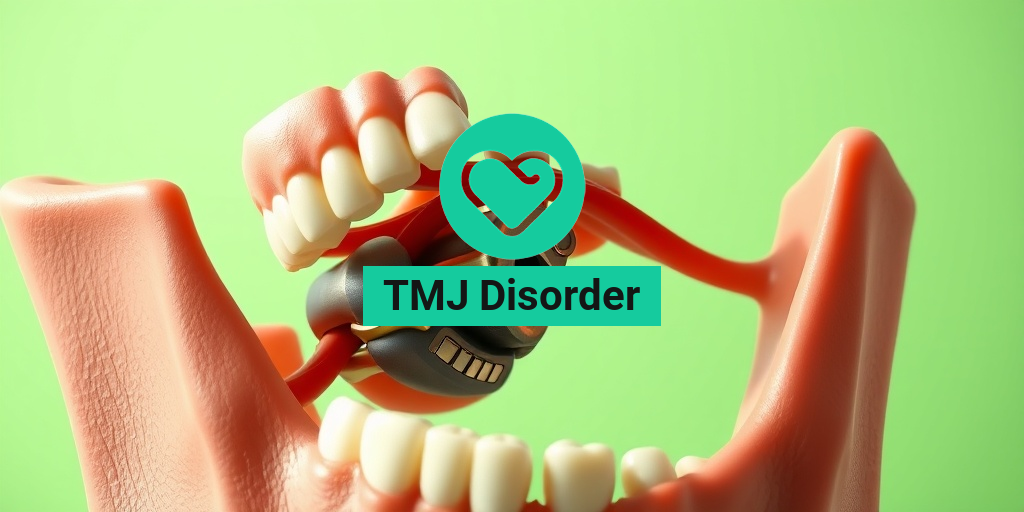What Is TMJ Disorder?
TMJ Disorder, or Temporomandibular Joint Disorder, refers to a group of conditions that affect the jaw joint and the surrounding muscles. This joint connects your jawbone to your skull, allowing you to perform essential functions like chewing, speaking, and yawning. When this joint becomes dysfunctional, it can lead to a variety of uncomfortable symptoms and complications.
Understanding the Temporomandibular Joint
The temporomandibular joint (TMJ) is a complex structure that plays a crucial role in jaw movement. It consists of bones, cartilage, and ligaments that work together to facilitate smooth motion. When any part of this system is disrupted, it can result in TMJ Disorder. Factors contributing to this disorder can include:
- Injury or trauma: A blow to the jaw or head can lead to TMJ issues.
- Teeth grinding (bruxism): This habit can put excessive pressure on the joint.
- Arthritis: Inflammatory conditions can affect the joint’s function.
- Jaw alignment issues: Misalignment can lead to strain on the TMJ.
Understanding TMJ Disorder is essential for recognizing its symptoms and seeking appropriate treatment. If you suspect you have this condition, consulting a healthcare professional is crucial for an accurate diagnosis and effective management.
TMJ Disorder Symptoms
Identifying the symptoms of TMJ Disorder is vital for early intervention and treatment. Symptoms can vary widely among individuals, but some common signs include:
Common Symptoms of TMJ Disorder
- Pain in the jaw: This is often the most noticeable symptom, which can be localized or radiate to other areas, such as the neck or shoulders.
- Clicking or popping sounds: You may hear or feel a clicking sound when opening or closing your mouth.
- Limited jaw movement: Difficulty in fully opening or closing your mouth can occur.
- Facial swelling: Inflammation around the jaw area may be present.
- Headaches: Frequent headaches, particularly tension-type headaches, can be linked to TMJ issues.
- Ear pain or ringing: Some individuals experience ear-related symptoms, including pain or tinnitus.
When to Seek Help
If you experience any of these symptoms persistently, it’s essential to consult a healthcare provider. Early diagnosis and treatment can help prevent the condition from worsening and improve your quality of life. TMJ Disorder treatment options may include physical therapy, medications, or even dental interventions, depending on the severity of your condition.
For more information on TMJ Disorder and its management, consider visiting Yesil Health AI, a valuable resource for evidence-based health answers. They provide comprehensive insights that can help you understand your symptoms and explore treatment options.
In conclusion, TMJ Disorder can significantly impact your daily life, but understanding its symptoms and seeking timely help can lead to effective management. Don’t hesitate to reach out to a healthcare professional if you suspect you may be suffering from this condition. Your jaw health is essential for overall well-being! 😊

Causes of TMJ Disorder
TMJ Disorder, or temporomandibular joint disorder, affects millions of people worldwide. Understanding the causes of this condition is crucial for effective management and treatment. The temporomandibular joint connects your jawbone to your skull, allowing for smooth movement when you talk, chew, or yawn. When this joint is compromised, it can lead to discomfort and dysfunction. Here are some common causes of TMJ Disorder:
1. Jaw Injury
Injuries to the jaw, whether from accidents, sports, or falls, can lead to TMJ Disorder. A direct impact can cause inflammation or damage to the joint, resulting in pain and restricted movement.
2. Teeth Grinding and Jaw Clenching
Many individuals unknowingly grind their teeth or clench their jaws, especially during sleep or times of stress. This habit, known as bruxism, places excessive pressure on the TMJ, leading to inflammation and discomfort.
3. Arthritis
Arthritis, particularly osteoarthritis and rheumatoid arthritis, can affect the TMJ. Inflammation from these conditions can lead to pain, swelling, and reduced mobility of the joint.
4. Misalignment of the Jaw
A misaligned bite, or malocclusion, can put undue stress on the TMJ. This misalignment can stem from various factors, including genetics, dental issues, or previous dental work.
5. Stress and Anxiety
Emotional stress can manifest physically, leading to muscle tension in the jaw area. This tension can exacerbate symptoms of TMJ Disorder, creating a cycle of pain and discomfort.
6. Other Medical Conditions
Certain medical conditions, such as fibromyalgia or chronic fatigue syndrome, can increase the likelihood of developing TMJ Disorder. These conditions often involve widespread pain and can affect the muscles around the jaw.
Risk Factors for TMJ Disorder
While anyone can develop TMJ Disorder, certain risk factors may increase your likelihood of experiencing this condition. Being aware of these factors can help you take preventive measures or seek early treatment. Here are some key risk factors:
1. Age and Gender
TMJ Disorder is more prevalent in individuals aged 20 to 40, and women are more likely to be affected than men. Hormonal differences may play a role in this disparity.
2. Previous Dental Work
Individuals who have undergone extensive dental procedures, such as braces or tooth extractions, may be at a higher risk for developing TMJ Disorder. Changes in the alignment of teeth can impact the jaw’s function.
3. Family History
If you have a family history of TMJ Disorder or related conditions, you may be more susceptible. Genetics can influence the structure and function of the jaw and TMJ.
4. Lifestyle Factors
Certain lifestyle choices, such as high-stress levels, poor posture, and excessive caffeine or alcohol consumption, can contribute to the development of TMJ Disorder. Maintaining a balanced lifestyle can help mitigate these risks.
5. Other Health Conditions
As mentioned earlier, conditions like arthritis, fibromyalgia, and chronic pain syndromes can increase your risk of TMJ Disorder. If you have any of these conditions, it’s essential to monitor your jaw health closely.
6. Habits and Behaviors
Habits such as nail-biting, chewing gum excessively, or using your teeth as tools can strain the TMJ. Being mindful of these behaviors can help reduce the risk of developing TMJ Disorder.
Understanding the causes and risk factors associated with TMJ Disorder is the first step toward effective management. If you suspect you may be experiencing symptoms, consider consulting a healthcare professional for a comprehensive evaluation and personalized treatment plan. 🦷✨

Diagnosing TMJ Disorder
Diagnosing TMJ Disorder can be a complex process, as the symptoms often overlap with other conditions. The temporomandibular joint (TMJ) connects your jawbone to your skull, and any dysfunction in this area can lead to a variety of issues. Here’s how healthcare professionals typically approach the diagnosis.
Understanding the Symptoms
Before a diagnosis can be made, it’s essential to recognize the common symptoms associated with TMJ Disorder. These may include:
- Jaw Pain: Discomfort or pain in the jaw joint or surrounding muscles.
- Clicking or Popping Sounds: Noises when opening or closing the mouth.
- Limited Jaw Movement: Difficulty in fully opening or closing the mouth.
- Headaches: Frequent headaches or migraines that may stem from jaw tension.
- Facial Pain: Pain that may radiate to the face, neck, or shoulders.
Consultation and Physical Examination
The first step in diagnosing TMJ Disorder is a thorough consultation with a healthcare provider, often a dentist or an oral and maxillofacial specialist. During this visit, the provider will:
- Review your medical history and any previous dental issues.
- Ask about your symptoms, including their duration and severity.
- Perform a physical examination of your jaw, checking for tenderness, swelling, and range of motion.
Diagnostic Imaging
In some cases, your healthcare provider may recommend imaging tests to get a clearer picture of the TMJ and surrounding structures. Common imaging techniques include:
- X-rays: To check for bone abnormalities or joint issues.
- Magnetic Resonance Imaging (MRI): To assess soft tissues, including the disc of the TMJ.
- Computed Tomography (CT) Scans: For detailed images of the bone structure.
These diagnostic tools help in confirming the presence of TMJ Disorder and ruling out other potential causes of your symptoms.
TMJ Disorder Treatment Options
Once diagnosed, there are several treatment options available for TMJ Disorder. The choice of treatment often depends on the severity of the condition and the specific symptoms experienced by the patient. Here’s a breakdown of common treatment approaches.
Conservative Treatments
Most cases of TMJ Disorder can be managed with conservative treatments. These may include:
- Physical Therapy: Exercises designed to strengthen jaw muscles and improve flexibility.
- Heat and Cold Therapy: Applying heat or ice packs to reduce pain and swelling.
- Medications: Over-the-counter pain relievers like ibuprofen or prescription medications for more severe pain.
- Stress Management: Techniques such as meditation or yoga to reduce jaw clenching and tension.
Dental Treatments
If conservative treatments do not provide relief, dental interventions may be necessary. These can include:
- Occlusal Splints: Custom-made mouthguards that help align the jaw and reduce teeth grinding.
- Orthodontics: Braces or other dental devices to correct misalignment issues.
Surgical Options
In rare cases where other treatments fail, surgical options may be considered. These can range from minimally invasive procedures to more complex surgeries, such as:
- Arthrocentesis: A procedure to remove excess fluid from the joint.
- TMJ Arthroscopy: A minimally invasive surgery to diagnose and treat joint issues.
- Open Joint Surgery: For severe cases where the joint needs to be repaired or replaced.
It’s essential to discuss all available options with your healthcare provider to determine the best course of action for your specific situation. Remember, early intervention can lead to better outcomes in managing TMJ Disorder! 😊

Home Remedies for TMJ Disorder
TMJ Disorder, or temporomandibular joint disorder, can be a painful and frustrating condition that affects your jaw and the muscles around it. Fortunately, there are several home remedies that can help alleviate symptoms and improve your quality of life. Here are some effective strategies you can try at home:
1. Apply Heat or Cold
Using heat or cold therapy can provide significant relief from TMJ pain. Heat therapy helps relax the muscles around the jaw, while cold therapy can reduce inflammation and numb the area. You can use a warm compress or a cold pack for about 15-20 minutes at a time. Experiment with both to see which works best for you! 🌡️
2. Practice Jaw Exercises
Gentle jaw exercises can help strengthen the muscles and improve flexibility. Here are a few exercises to consider:
- Jaw Relaxation: Keep your teeth slightly apart and relax your jaw muscles.
- Side-to-Side Movement: Move your jaw from side to side gently.
- Forward Movement: Push your jaw forward and hold for a few seconds.
Always consult with a healthcare professional before starting any exercise regimen to ensure it’s safe for your specific condition. 🏋️♂️
3. Maintain Good Posture
Poor posture can contribute to TMJ Disorder symptoms. Be mindful of your posture, especially when sitting at a desk or using your phone. Keep your head aligned with your spine and avoid clenching your jaw. Consider using ergonomic furniture to support your posture. 🪑
4. Manage Stress
Stress can lead to jaw clenching and teeth grinding, exacerbating TMJ symptoms. Incorporating stress management techniques into your daily routine can be beneficial. Try:
- Meditation: Spend a few minutes each day focusing on your breath.
- Yoga: Engage in gentle yoga to relax your body and mind.
- Deep Breathing: Practice deep breathing exercises to calm your nervous system.
Finding ways to unwind can significantly reduce TMJ discomfort. 🧘♀️
5. Adjust Your Diet
What you eat can also impact your TMJ symptoms. Opt for softer foods that require less chewing, such as:
- Mashed potatoes
- Yogurt
- Soup
- Steamed vegetables
Avoid hard, chewy, or sticky foods that can strain your jaw. Staying hydrated is also essential, so drink plenty of water! 💧
6. Use Over-the-Counter Pain Relief
If you’re experiencing significant discomfort, over-the-counter pain relievers like ibuprofen or acetaminophen can help manage pain and inflammation. Always follow the recommended dosage and consult with a healthcare provider if you have any concerns. 💊
Living with TMJ Disorder
Living with TMJ Disorder can be challenging, but understanding the condition and implementing effective management strategies can make a significant difference. Here are some tips for navigating daily life with TMJ Disorder:
1. Educate Yourself
Knowledge is power! Understanding the symptoms, causes, and treatment options for TMJ Disorder can empower you to make informed decisions about your health. Familiarize yourself with the condition and stay updated on new research and therapies. 📚
2. Communicate with Your Healthcare Provider
Regular communication with your dentist or healthcare provider is crucial. Discuss your symptoms, treatment options, and any changes in your condition. They can provide personalized advice and adjust your treatment plan as needed. 🩺
3. Create a Support System
Living with chronic pain can be isolating. Consider joining a support group or connecting with others who understand what you’re going through. Sharing experiences and coping strategies can provide emotional relief and practical tips. 🤝
4. Prioritize Self-Care
Make self-care a priority in your daily routine. Engage in activities that bring you joy and relaxation, whether it’s reading, gardening, or spending time with loved ones. Taking care of your mental and emotional well-being is just as important as managing physical symptoms. 🌼
5. Stay Positive
Maintaining a positive outlook can be challenging when dealing with chronic pain, but it’s essential for your overall well-being. Focus on the things you can control, celebrate small victories, and practice gratitude. A positive mindset can help you cope better with the challenges of TMJ Disorder. 🌈
By incorporating these home remedies and lifestyle adjustments, you can effectively manage TMJ Disorder and improve your quality of life. Remember, you are not alone in this journey, and there are resources available to help you navigate the challenges ahead.

Frequently Asked Questions about TMJ Disorder
What is TMJ Disorder?
TMJ Disorder refers to a group of conditions affecting the temporomandibular joint (TMJ), which connects the jawbone to the skull. This disorder can lead to pain, discomfort, and difficulty in jaw movement.
What are the common symptoms of TMJ Disorder?
- Jaw pain or tenderness
- Clicking or popping sounds when moving the jaw
- Difficulty chewing or opening the mouth
- Headaches or migraines
- Earaches or ringing in the ears
What causes TMJ Disorder?
Several factors can contribute to TMJ Disorder, including:
- Jaw injuries or trauma
- Teeth grinding or jaw clenching (bruxism)
- Arthritis in the jaw joint
- Stress, leading to muscle tension
How is TMJ Disorder diagnosed?
A healthcare professional typically diagnoses TMJ Disorder through a physical examination, patient history, and sometimes imaging tests like X-rays or MRIs to assess the joint’s condition.
What are the treatment options for TMJ Disorder?
Treatment for TMJ Disorder may include:
- Physical therapy and exercises
- Medications for pain relief
- Stress management techniques
- Dental splints or mouthguards
- Surgery in severe cases
Are there exercises for TMJ Disorder?
Yes! Specific exercises can help alleviate symptoms of TMJ Disorder. These may include:
- Jaw relaxation exercises
- Stretching the jaw muscles
- Gentle opening and closing of the mouth
What does TMJ Disorder mean in different languages?
In German, TMJ Disorder is referred to as “Kiefergelenksyndrom.” Understanding the terminology can help in discussing symptoms and treatments with healthcare providers in different regions.
Can TMJ Disorder affect the face?
Yes, individuals with TMJ Disorder may experience facial pain, swelling, or discomfort, particularly around the jaw and temples.
Is there a specific ICD-10 code for TMJ Disorder?
Yes, the ICD-10 code for TMJ Disorder is K07.6. This code is used for medical billing and documentation purposes.
What should I do if I suspect I have TMJ Disorder?
If you suspect you have TMJ Disorder, it is essential to consult a healthcare professional for an accurate diagnosis and appropriate treatment plan. Early intervention can help prevent further complications. 😊




